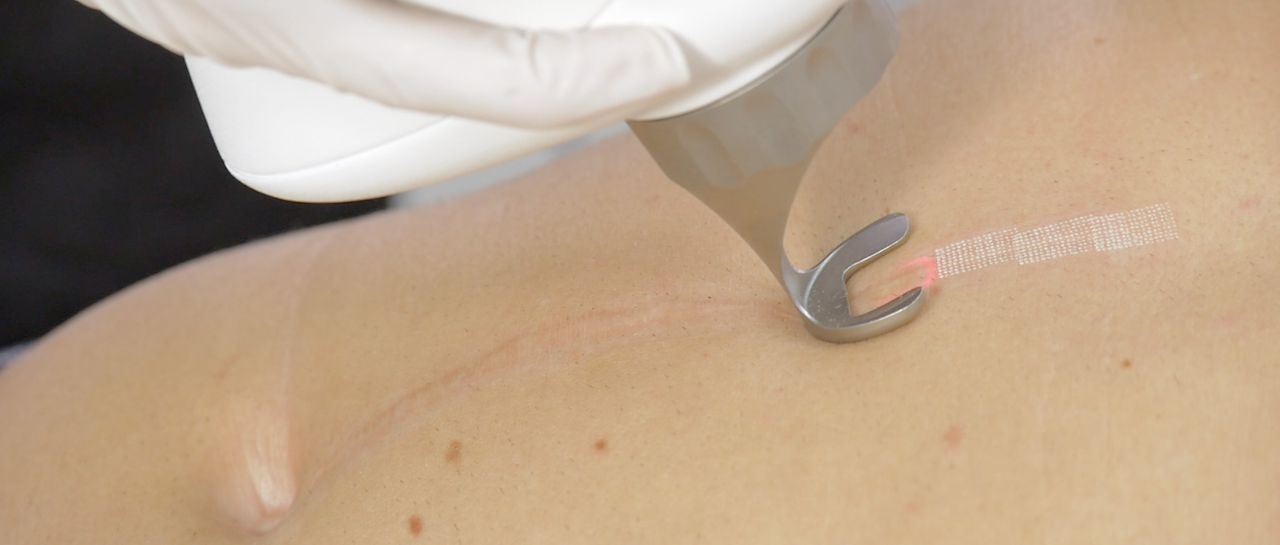Laser scar treatment is a highly effective method for reducing and treating scars. The procedure can significantly improve the appearance of:
- Surgical scars
- Injury-related scars
- Burn scars
- Stretch marks
What laser is used for scar treatment at Dr. Mari Laasma’s Aesthetic and Laser Clinic?
We use the Fotona Dynamis Pro laser, which removes the outer layer of damaged skin in the treated area and stimulates the production of new skin cells.
As a result, the damaged skin is gradually replaced by healthier, new tissue.
Additionally, our clinic is equipped with the unique Fotona F-22 Er:YAG scanner, which enhances the effectiveness of fractional laser resurfacing.
The F-Runner is a computer-guided scanning device developed specifically for precise Er:YAG fractional treatments. It allows for highly customizable control over penetration depth and heat intensity, enabling the treatment of all scar types, especially acne scars.
Visible improvements may occur within weeks or months, and multiple sessions may be required for optimal results depending on the scar type.
Benefits of Laser Scar Treatment
- Highly effective scar reduction
- Stimulates production of new skin cells
- Activates collagen and elastin synthesis
- Tightens the skin while resurfacing the scar
- Precisely targeted treatment
- Leaves surrounding skin unharmed
Which laser treatment is right for your scar?
As part of a comprehensive scar treatment plan, we may combine different methods and laser wavelengths for better and faster results.
A specialist will determine the scar type:
- Atrophic scar – below the skin level
- Hypertrophic scar – raised above the skin surface
- Keloid – extends beyond the original wound and is considered an overgrowth of scar tissue
Keloids are often treated initially with steroid injections due to their tumor-like behavior. Only very superficial laser resurfacing may be performed on keloids to avoid stimulating further growth.
Stretch Marks (Striae)
Stretch marks are skin lesions in the outermost layer, appearing as pink, red, or purplish lines on areas like the hips, abdomen, breasts, upper arms, thighs, or buttocks. Over time, they fade into white or pale gray lines.
Common causes:
- Pregnancy
- Rapid weight changes
- Genetic predisposition
- Skin stretching
- Hormonal shifts
- Use of anabolic substances
While stretch marks don’t disappear completely on their own, they can be significantly reduced with laser resurfacing.
Acne Scar Treatment
Laser light is used to break down scar tissue on the surface layers of the skin while simultaneously stimulating the growth of new, healthy skin cells.
In addition to facial scars, laser therapy can treat acne scars on the back, chest, arms, and neck.
Depending on the scar’s type, age, and pigmentation, optimal results are often achieved by combining different wavelengths and other treatments such as:
- Carboxytherapy
- PRF injections (iPRF or aPRF)
- Steroid therapy
What to expect after laser scar treatment?
- Recovery time varies; healing usually takes 3–10 days, depending on scar depth and location
- Results are not immediate – visible improvement may take weeks or even months
- Avoid direct sun exposure for 4–6 weeks after treatment
- Use cold packs or damp cloths to reduce swelling
- OTC pain relievers may be used if needed
- Clean the treated area gently with an antiseptic and moisturize daily
- Avoid friction on the treated area until fully healed
- For facial treatments, avoid makeup and harsh skincare products for a few days
How to prepare for laser scar treatment:
- Avoid smoking for at least two weeks before treatment
- Inform your specialist about any medications you are taking
- 2–4 weeks before treatment, discontinue using products with retinol or glycolic acid on the area
- Use sunscreen and avoid prolonged sun exposure pre-treatment
Can scar formation be prevented?
While some scars depend on individual tissue and collagen response, early care and topical treatment can reduce scarring.
- Follow your specialist’s recommendations
- Begin moisturizing as soon as the scab falls off
- Use silicone creams or patches
- Protect the area from sun exposure year-round, especially during the first 12 months after the scar forms
Laser Biomodulation (Photobiomodulation)
Our clinic also offers laser biomodulation, a clinically proven, non-invasive therapy for wound and scar healing.
It supports faster recovery, reduces pain and inflammation, and can shorten post-surgical healing time.
When started immediately after skin trauma, photobiomodulation may even prevent visible scarring in some cases.

